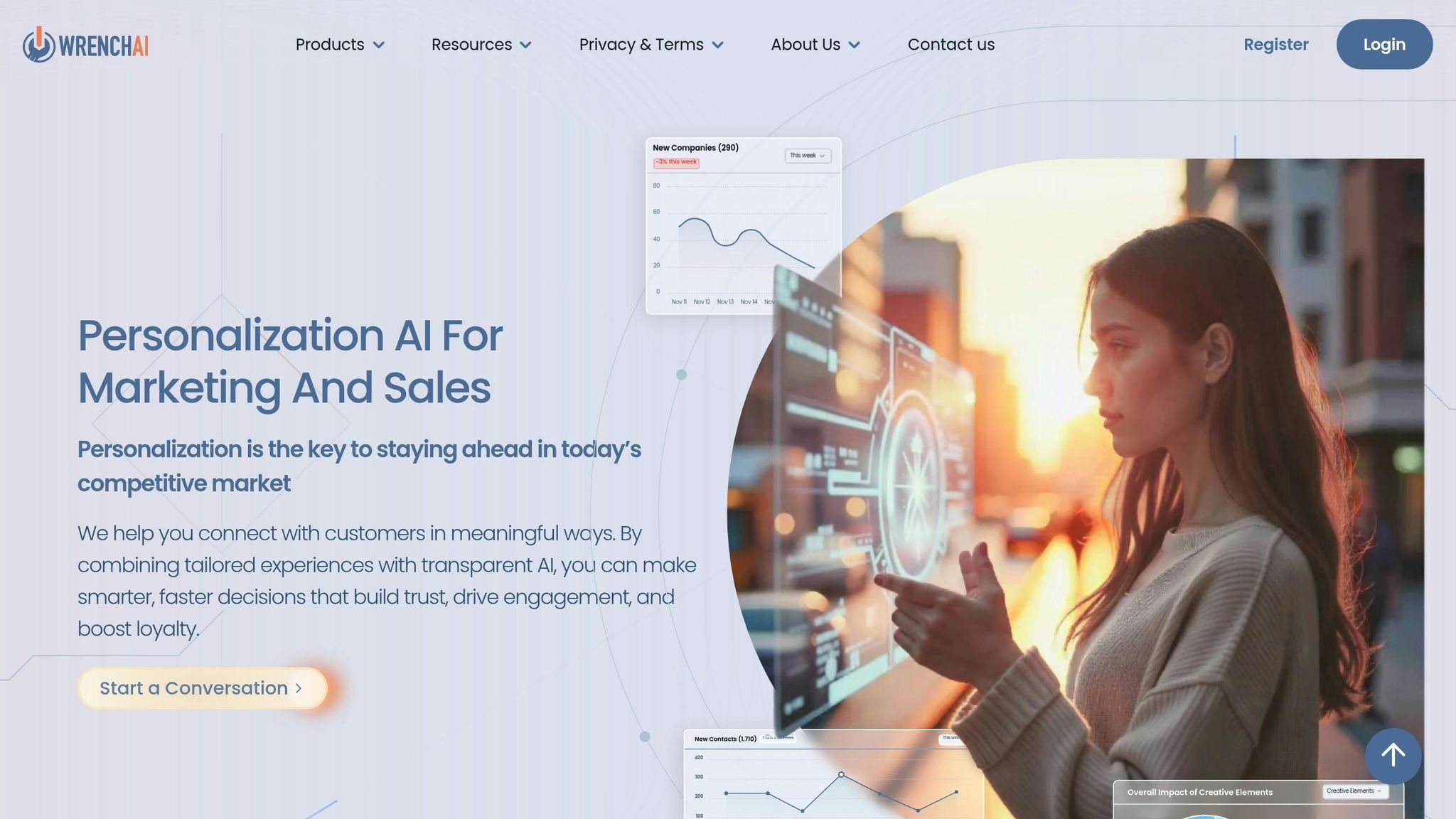AI is transforming how marketers allocate budgets. By using real-time data, machine learning, and predictive analytics, AI helps marketers make smarter, faster decisions about where to spend their money. Unlike traditional methods, AI continuously analyzes performance data, adjusts allocations, and forecasts trends, ensuring every dollar is spent effectively.
Key Takeaways:
- What It Does: AI-driven budget allocation distributes funds across channels and campaigns based on real-time performance, audience behavior, and market trends.
- Why It Matters: It eliminates human bias, improves cost efficiency, and ensures campaigns remain competitive in dynamic markets.
- How to Start:
- Prepare your data: Clean, integrate, and ensure compliance.
- Use a mix of fixed (70%) and flexible (30%) budgets for stability and adaptability.
- Train your team to interpret AI insights and collaborate effectively.
- Leverage platforms like Wrench.AI for segmentation, predictive analytics, and automated workflows.
AI doesn’t replace human expertise; it enhances it. With clear KPIs, automated workflows, and proper training, marketers can maximize ROI and stay ahead in today’s fast-paced digital landscape.
AI Marketing Workflow: Budget Optimization Agent
Data and Infrastructure Preparation Checklist
Getting your marketing infrastructure ready with clean, well-connected data is a must for effective AI implementation. Nearly 70% of marketers face technical hurdles when using AI for marketing, including data compatibility and integration issues [1]. The good news? These challenges are avoidable with proper planning. Remember, your AI system is only as good as the data it processes. Below is a checklist outlining essential steps for preparing your data, ensuring integration, and meeting compliance standards to support AI-driven budget allocation.
Data Integration and Cleaning Requirements
For your AI budget allocation system to work effectively, it needs access to clean, structured data from various sources. Start by auditing your data streams to understand how information flows through your tools. Common data sources include CRM systems, Google Analytics, Facebook Ads Manager, email marketing platforms, and customer data platforms. Since these systems often store data in different formats, standardizing naming conventions and update schedules is crucial. AI tools perform best when they can smoothly ingest data from these sources and provide actionable insights back into your marketing ecosystem [1].
Take steps to eliminate duplicate entries, standardize naming conventions, and address any missing data promptly. Consistency in data naming is key to generating accurate AI recommendations. Regular validation processes – like automated checks for missing tags or unusual spending patterns – help ensure that your AI system is working with reliable data. Accurate data leads to better budget recommendations and more responsive campaign adjustments. Also, think about how frequently your data updates: real-time budget optimization demands near-real-time data feeds, not just daily updates.
API Compatibility and System Setup
Before choosing an AI budget allocation platform, evaluate your current marketing tech stack to ensure it supports API connections and data sharing [2]. Your tools need to communicate seamlessly with AI systems to enable smooth data flow and automation [3]. Start by reviewing your marketing tools and testing their API connections to confirm bidirectional data flow. Check if your CRM, analytics platforms, and ad accounts support these connections – older systems might require updates or even replacement.
Pay close attention to data formatting, update intervals, and any restrictions on data transfer volumes. Document integration requirements early, including permissions, sync schedules, and backup plans for failed connections. Collaborate with your IT team to identify and resolve any compatibility issues before they disrupt your budget allocation efforts.
Data Privacy and Compliance Requirements
Using AI for budget allocation involves handling customer data, so staying compliant with U.S. privacy regulations like the California Consumer Privacy Act (CCPA) is non-negotiable [4]. To meet these standards, allocate resources for data anonymization, encryption, and access controls. Developing a robust data governance plan that outlines access, storage, and retention policies is critical.
Secure your data by encrypting it both at rest and in transit, and anonymize sensitive information to reduce privacy risks. Implement role-based access controls to ensure only authorized personnel can view or manipulate specific datasets. Regularly audit your AI systems to confirm data integrity and security throughout their lifecycle. By investing in these compliance measures upfront, you can minimize risks and build trust with your customers [4]. With secure and compliant data, you’re well-positioned to optimize budget allocation in the next stages of your planning.
Budget Planning and Channel Allocation Checklist
Once your data and technical setup are in place, the next step is to focus on how you distribute your marketing budget. With a strong data foundation, you can use AI-driven insights to make smarter spending decisions. Research shows that AI can improve efficiency by 20–30% [6], helping you balance tried-and-true channels with thoughtful experimentation. The key isn’t to spread your budget evenly but to align it with the channels where your audience is most likely to engage and convert, while staying flexible enough to adapt when needed.
Audience Segment and Channel Analysis
AI is particularly effective at identifying which audience segments perform best on specific channels, but the setup for this analysis is crucial. Start by defining your core audience segments and then use AI to assess which channels – like social media, search, email, or display ads – deliver the highest return on ad spend (ROAS) for each group.
Dive deeper into patterns like customer lifetime value (CLV) by combining audience segments with channel performance. For instance, professional networking platforms might be better for reaching high-value B2B customers, whereas younger demographics may respond more enthusiastically on platforms like TikTok or Instagram. Use these insights to map channels to specific segments, guiding your initial budget allocations. Additionally, pay attention to seasonal trends and timing patterns identified by AI. Some audience segments may respond better to particular channels at specific times, such as certain months or even days of the week. By integrating these insights, you can create dynamic allocation rules that ensure your budget is spent where and when it will have the most impact.
Fixed vs. Flexible Budget Planning
To make AI-driven budgeting work, you need a balance between stability and adaptability. A good rule of thumb is to allocate about 70% of your budget to proven, reliable channels and 30% to flexible, performance-driven initiatives [5][7]. Fixed budgets should cover channels with a consistent track record, like search ads, email campaigns, and high-performing social platforms. These provide a steady foundation for your marketing efforts.
The remaining flexible portion of your budget allows for real-time adjustments based on performance data. This approach shifts you away from static, annual planning toward more fluid, performance-based decisions. For example, if a new campaign on a social platform starts outperforming expectations, you can quickly reallocate funds to capitalize on that momentum. Sticking to a consistent framework also helps your AI tools learn and optimize within those parameters, improving results over time.
Innovation Budget Allocation
Set aside about 10% of your budget for exploring new opportunities. Use AI to track emerging platforms and trends, giving you the chance to experiment without risking your core revenue channels.
AI can identify promising trends, but human judgment is essential to assess whether these opportunities align with your brand, resources, and overall strategy. This combination of AI insights and human oversight ensures that you’re not blindly following algorithms but making thoughtful, strategic investments in areas with real potential for growth.
As you roll out your budget plan, keep a close eye on performance metrics and adjust allocations based on your key performance indicators (KPIs). This ongoing optimization will help you make the most of every dollar spent.
Performance Tracking and Optimization Checklist
Once your budget planning is in place, the next step is to ensure you’re getting the most out of every dollar spent. This is where performance tracking and optimization come into play. With AI processing real-time performance data, your focus should be on creating workflows that monitor results and make adjustments based on the data. The ultimate goal? A feedback loop where AI continuously learns from campaign performance and fine-tunes spending to maximize returns.
KPI Setup and Performance Monitoring
Start by defining clear, measurable KPIs like cost per acquisition (CPA), return on ad spend (ROAS), and customer lifetime value (CLV). Use real-time dashboards to track these metrics across campaigns, channels, and audience segments. To stay ahead, set performance thresholds that trigger alerts or adjustments when certain conditions are met.
While traditional metrics like click-through rates and impressions still matter, AI thrives on more detailed performance indicators. Ensure your tracking system captures data at a granular level – monitoring variations by time of day, week, or even month. For instance, some campaigns may perform better during specific hours or days, which can guide timely budget shifts.
If a campaign’s ROAS consistently falls below your target, your AI system should flag it for review or automatically reduce spending. On the flip side, when campaigns outperform expectations, the system should quickly identify opportunities to scale up investment.
Attribution models are another key tool. By tracking the customer journey across multiple touchpoints, AI can pinpoint which channels are most effective at different stages of the funnel. This insight allows you to allocate budgets based on overall impact rather than relying solely on last-click attribution.
Budget Optimization Based on Data
AI-driven budget optimization relies on analyzing performance trends and reallocating funds to the best-performing campaigns and channels. Configure your system to make automatic adjustments within predefined limits, allowing for moderate shifts without losing control.
Predictive analytics can be a game-changer here. AI can spot early signs of a campaign losing steam or identify a new audience segment that’s gaining traction. This proactive approach lets you reallocate funds before performance dips, keeping your campaigns running smoothly.
Incorporate A/B testing into your budget strategy. When experimenting with new creative, audiences, or channels, let AI manage the process. It can automatically increase investment in options that perform well and scale back on underperformers. Over time, this creates a system that fine-tunes itself for better results with minimal manual input.
Cross-channel interactions are another area to monitor. AI can reveal how increased spending in one channel might boost performance in another, helping you optimize your overall budget mix. For example, a boost in social media ads might amplify search engine conversions, offering insights you can act on.
Dynamic bidding strategies are essential for staying competitive. AI can adjust bids in real time based on performance data, competitor activity, and market trends. During high-conversion periods, bids can increase to capture more opportunities, while lower-performing times see reduced spending – ensuring you get the best return on your investment.
Workflow Automation Implementation
Automating routine budget tasks can save time and improve efficiency. Set up workflows that automatically pause campaigns that underperform, increase budgets for high-performers, and redistribute funds across channels based on predefined rules. This ensures optimization happens even when your team is focused on other priorities.
Automated reporting is another time-saver. Instead of manually compiling reports, use AI to generate customized dashboards that provide insights into budget performance, recent adjustments, and strategic recommendations. These reports can be delivered to stakeholders on a regular schedule, keeping everyone informed without extra effort.
For more control, implement approval workflows. Minor changes can execute automatically, while major adjustments require human review. This strikes a balance between automation and oversight.
Integrating your AI budget system with other marketing tools is also crucial. For example, if your CRM identifies high-value prospects or inventory levels change, your campaign budgets can be adjusted automatically to maintain optimal cost-per-sale ratios.
Finally, create feedback loops that allow your AI system to learn from both successes and failures. If manual overrides lead to better outcomes than automated decisions, ensure this information is fed back into the AI’s learning algorithms. This ongoing refinement helps the system improve over time.
For situations where automated systems encounter anomalies or unusual conditions, establish clear escalation procedures. This ensures human experts can step in quickly when needed, while automation continues to handle routine tasks efficiently.
sbb-itb-d9b3561
Team Training and Change Management
After tackling the technical aspects of AI integration, the next step is preparing your team to effectively manage these tools. Implementing AI-driven budget allocation isn’t just about adopting the right technology – it’s about ensuring your team knows how to collaborate with AI systems. Transitioning from manual to AI-powered budgeting requires training your team to see AI as an asset, not a replacement.
Building confidence through education and ongoing support is essential for a smooth transition. Studies and real-world experiences show that well-structured training significantly improves how teams incorporate AI into their daily workflows. Organizations that embrace a formal change management process tend to adapt to new technologies more effectively. These training efforts should align with earlier steps like data integration and automation, creating a seamless adoption process.
AI Insights Training for Teams
Equip your team with the skills to understand and act on AI-generated insights. Start by teaching the basics – how AI processes budget data and generates actionable recommendations. Team members need to differentiate between insights that require immediate action and those that can be monitored over time.
Hands-on training sessions are invaluable. Use real campaign data to help your team practice interpreting AI recommendations. Data literacy is key here. Your team should be comfortable navigating performance dashboards, spotting statistical trends, and identifying patterns. They also need to recognize when AI recommendations might be influenced by incomplete data or temporary market shifts that don’t warrant permanent changes.
Tailor training to specific roles. For instance:
- Campaign managers should focus on how AI optimizes bids and manages budget pacing.
- Creative teams should understand how AI evaluates content performance to guide budget decisions.
- Marketing directors should concentrate on strategic insights and long-term planning based on AI recommendations.
Comprehensive training, paired with clear documentation, ensures your team feels confident in using AI tools effectively.
Clear Communication About AI Decisions
Transparency is critical. Document AI recommendations with decision logs that explain the reasoning behind each adjustment. These logs serve as both a learning tool and a way to build trust in the system. When team members see consistent improvements driven by AI, they’re more likely to embrace its suggestions.
Schedule regular team discussions to review AI insights and recommendations. Encourage open dialogue – team members should feel comfortable questioning AI suggestions, especially when they conflict with market knowledge or brand priorities. This collaborative approach reinforces the idea that AI complements human expertise rather than replacing it.
Establish clear protocols for handling AI anomalies. Make sure your team knows when to step in, how to escalate issues, and how to document interventions. Over time, these measures can help refine AI processes and improve overall performance.
It’s also important to communicate the broader purpose of AI adoption. Help your team understand how AI-driven budgeting aligns with business goals, boosts campaign performance, and frees them to focus on strategic, high-value tasks instead of repetitive ones.
Gradual AI Implementation with Support
Start small. Roll out AI tools in low-risk campaigns first, keeping human oversight in place until your team gains confidence. This phased approach minimizes risks and allows your team to validate AI suggestions against their own expertise.
Begin with AI-assisted decisions where humans remain actively involved. This gives your team a chance to test the system’s recommendations, cross-checking them with their market knowledge. Over time, this builds trust in the AI’s capabilities and ensures a smoother transition.
Identify and train AI champions within your team. These individuals can provide advanced support to their colleagues and offer feedback to fine-tune system settings. Their insights can help improve the accuracy of AI recommendations.
Create feedback loops to capture your team’s experiences during the rollout. Regular check-ins can highlight areas where additional training or system adjustments are needed, ensuring issues are addressed quickly.
Lastly, measure success beyond just campaign performance. Track metrics like team confidence, time saved on routine tasks, and the frequency of manual overrides. These indicators will show how well your team is adapting to AI workflows and where additional support might be needed.
For added support, consider working with AI platform providers that offer training and ongoing assistance. Having access to experts during the implementation phase can help resolve challenges quickly, making the adoption process smoother and less stressful for your team.
Using Wrench.AI for Marketing Budget Allocation

Building on earlier discussions about data and team readiness, Wrench.AI takes budget allocation to the next level with its focused and efficient approach. If you’re looking for a platform to streamline your marketing budget allocation, Wrench.AI offers tools that combine automation and real-time insights to make the process smarter and more effective.
The platform’s strategy revolves around three main strengths: accurate audience segmentation, predictive analytics for timely adjustments, and automated workflows. Together, these features help ensure your marketing dollars are directed toward the most impactful channels and campaigns, while still giving your team the clarity and control they need. Here’s a closer look at how Wrench.AI refines segmentation for better budget decisions.
Audience Segmentation and Campaign Tools
Wrench.AI’s audience segmentation tools are designed to make budget allocation more effective. By analyzing customer behavior, purchase patterns, and engagement data, the platform creates detailed audience segments that highlight where your budget can have the greatest impact. Instead of spreading funds across broad demographics, you can focus on segments with the highest potential for conversions.
The platform consolidates data from various sources, giving you a complete view of your audience. Whether customers engage via email, social media, or your website, Wrench.AI captures these interactions to build comprehensive customer profiles. This ensures your budget decisions are based on a holistic understanding of your audience.
In addition to segmentation, Wrench.AI offers campaign optimization tools that align budget allocation with performance data. The platform tracks campaign performance across audience segments and suggests reallocating funds when certain groups show higher engagement or conversion rates. This removes guesswork from the equation, allowing your budget to adapt to actual customer behavior instead of assumptions.
For B2B marketers, the platform’s account-based insights add another layer of precision. Wrench.AI identifies high-value prospects and existing customers, enabling you to allocate more resources to accounts with the greatest revenue potential. This targeted strategy maximizes your return on investment by focusing on accounts that matter most.
Predictive Analytics and Real-Time Changes
Wrench.AI’s predictive analytics capabilities allow you to be proactive with your budget allocation. By analyzing past performance, seasonal trends, and market conditions, the platform forecasts which channels and campaigns are likely to perform best in the future. This helps you allocate funds ahead of peak performance periods, so you’re ready to capitalize on opportunities before they pass.
The platform also enables real-time budget adjustments, outperforming traditional static budgeting methods. It continuously monitors campaign performance and can automatically reallocate funds when new opportunities arise. For example, if social media campaigns suddenly outperform email marketing, Wrench.AI can shift resources to the higher-performing channel without requiring manual intervention.
Its predictive models consider factors like customer value, seasonal patterns, and competitive dynamics to ensure reallocations are based on meaningful data rather than short-term fluctuations. Additionally, Wrench.AI’s transparent AI processes provide clear explanations for its budget recommendations, giving your team the confidence to validate decisions against their own market knowledge and priorities.
Automated Workflows and Data Integration
Managing budgets manually can be time-consuming, but Wrench.AI simplifies this with automated workflows. The platform can execute approved budget changes, update campaign settings across platforms, and generate detailed performance reports to guide future decisions. This automation allows your team to focus on strategy and creative efforts instead of administrative tasks.
Wrench.AI also excels in data integration, connecting seamlessly with major advertising networks, CRM systems, email tools, and analytics platforms. This ensures your budget allocation decisions are informed by performance data from all channels, not just isolated metrics from individual platforms.
For businesses with unique needs, Wrench.AI offers custom API configurations. Whether you’re importing data from proprietary systems or processing it in specific ways, the platform’s flexible architecture adapts to your requirements without disrupting your existing workflows.
The platform’s scalable pricing model makes it accessible for businesses of all sizes. You only pay for the features and insights you use, allowing you to start small and expand as needed. For organizations with complex marketing setups, custom API plans and integration with existing data warehouses provide additional flexibility, making it easy to incorporate Wrench.AI without overhauling your current infrastructure.
Key Takeaways for AI Budget Allocation
Using AI for budget allocation is about finding the right balance between advanced technology and human expertise. Start by building a strong data foundation – this means integrating, cleaning, and ensuring compliance with data regulations. Without clean and reliable data, AI recommendations can quickly become ineffective.
Equally important is preparing your team. Equip them with the tools and training to interpret AI-driven insights. While AI can uncover patterns and trends, it’s your team’s market knowledge that ensures these insights are applied effectively. This collaboration is key to a smoother and more impactful implementation.
When planning your budget, aim for flexibility. Dedicate part of your resources to predictable allocations, but leave room for AI-driven adjustments. This allows you to test emerging trends while still safeguarding your core investments. This dual approach ensures that your strategy adapts to opportunities without compromising stability.
Clear KPIs are essential for guiding AI optimizations. AI thrives on identifying patterns in areas like customer lifetime value, conversion rates, and channel performance. However, it needs defined targets to work effectively. Setting measurable goals aligned with your business objectives gives AI a clear direction for its recommendations.
Once you’ve set up robust performance tracking, automation becomes the next step. The true power of AI-driven budget allocation lies in its ability to act in real time. Platforms like Wrench.AI use precise segmentation, predictive analytics, and automated workflows to dynamically reallocate funds to high-performing channels. This eliminates the delays of manual adjustments, ensuring your marketing dollars are directed where they’ll have the most impact – based on real customer behavior, not assumptions.
It’s important to recognize that AI isn’t a replacement for human judgment. Instead, it’s a tool to enhance decision-making. The best results come from combining AI’s ability to recognize patterns with marketers’ strategic and creative expertise. This shifts the focus from manual data analysis to interpreting AI recommendations and making strategic decisions about resource allocation.
Lastly, success should be measured beyond cost savings. Look for improvements in marketing effectiveness, such as higher conversion rates, optimized customer acquisition costs, and better use of resources across channels. These results demonstrate the value of AI budget allocation and provide insights for future strategies.
FAQs
How can marketers ensure their data is accurate and compliant for AI-driven budget allocation?
To keep data accurate and compliant for effective AI-driven budget allocation, marketers should focus on regular data audits and cleansing routines. These practices help catch and fix errors or inconsistencies, ensuring the data remains reliable and ready to use.
Using AI-powered tools for data governance can take this a step further by automating tasks like spotting errors, enforcing standards, and monitoring compliance. These tools not only protect data but also ensure it aligns with privacy regulations. With clean, secure, and compliant data, marketers can make smarter decisions and allocate resources more efficiently.
How can marketing teams effectively incorporate AI tools into their budget planning?
To make the most of AI tools in your marketing budget planning, start by setting clear goals and understanding how these tools can help achieve them. Begin with a modest allocation – around 20–30% of your budget – for AI-powered projects. This approach gives you the flexibility to experiment and adjust as you gather insights.
Keep a close eye on performance metrics to assess how these tools are influencing your campaigns. As you see positive results and gain confidence, you can gradually increase your investment. Regularly revisit outcomes to ensure they align with your overall marketing strategy, watch for any biases, and fine-tune your spending to maximize ROI.
With a thoughtful, data-focused strategy, your team can harness AI to make smarter decisions, streamline processes, and achieve stronger results.
How does Wrench.AI help marketers optimize their budget allocation?
Wrench.AI helps marketers make smarter choices about how to spend their budgets by using AI to analyze massive datasets in real-time. This means you can target your audience more accurately, adjust strategies on the fly, and allocate resources more effectively – all leading to a higher ROI.
Traditional methods often depend on manual processes and outdated, static data. Wrench.AI changes the game with advanced features like audience segmentation, campaign optimization, and workflow automation. These tools ensure your marketing dollars go toward strategies that truly make a difference.




